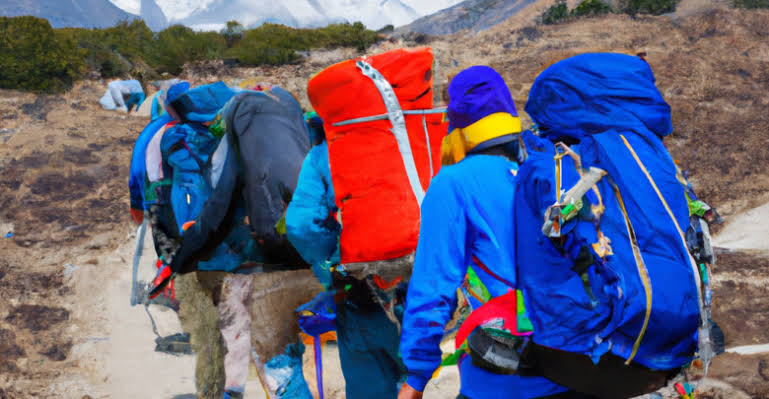For trekkers from all over the world, the Everest Base Camp trek is a bucket-list journey. Not only is it a chance to be at the base of the world’s tallest mountain, but also a trek through some of the most beautiful mountain landscapes and culturally rich places of Nepal. Yet, the rugged terrain, sudden weather changes and altitude conditions mean that trekking in Nepal requires adequate preparation, skill and support for it to be successful and safe. That’s where a Sherpa guide and crew come in handy. The Sherpas, masters of traversing the formidable landscapes of the Himalayas, are the lifeblood of this expedition, offering essential support in safety, navigation, and cultural perspective along the way.
Sherpas are famous for their mountaineering skills and knowledge of the Everest region. They are not only key to traversing the difficulty but also keeping trekkers spaced out to acclimatize at the high altitudes. The consequences of altitude sickness can be serious, and sherpas are trained to identify early symptoms and act promptly. Whether it’s tweaking the pace of the trek or suggesting a layover to acclimatize to altitude, sherpas help mitigate this risk. They can read signs of fatigue, dehydration or altitude sickness, and adapt plans on the spot to make sure trekkers are OK. They provide personalized assistance to trekkers, ensuring a slow and steady pace of the trek will help the body acclimatize the best.
Everest Base Camp trek August These helpers not only physically guide trekkers but also offer rich cultural explorations of the region and its people. The Everest Base Camp trek is equally a spatial challenge as much as it is cultural. Along the way as you trek through Sherpa villages and visit Buddhist monasteries, attend to prayer wheels and stupas, giving you insight into the local lives and spiritual practices. Sherpas are deeply tied to their culture, and many tell engaging tales about the area’s history, the importance of Everest to the local villages and his or her own background. Their presence serves as a bridge from trekker to native culture, giving respect to the birthplace between layers of fuzziness in the cool, high mountain breezes.
You will most likely receive this support if you hire a Sherpa team as guides on your trek. Trekking to Everest Base Camp is a physical challenge, and having a knowledgeable guide who knows the route can make the mental and physical stress of the trek easier. Sherpas carry the heavy loads, set the pace, and handle the logistics of the journey so trekkers can concentrate on the adventure and soak in the breathtaking views. In addition to making sure that the five-day trek is safe, Sherpas provide the emotional support that can be vital on a physically grueling journey. They are always there to bring positivity, which helps trekkers tide over difficult days when the going gets tough.
The logistics of the trek, such as where to sleep and what to eat, are all taken care of by the Sherpa team. The Sherpas know the trekking lodges along the way, so they make sure trekkers are laying their heads and beaks, respectively, in comfort and are well-fed (the Sherpas advise what to eat to aid in high-altitude acclimatization, energy production, and hydration). They also have extensive experience working with the unpredictable weather of the Himalayas, changing the itinerary as necessary to avoid dangerous weather and keeping the group safe.
The Everest Base Camp trek September is a challenging hike, but it is so rewarding. The accomplishment of simply being at the base of the Everest amidst of the peaks and marvelous sceneries is phenomenal. Travelling with a Sherpa team helps to ensure that you reach your destination safely and comfortably, while adding the cultural, historical and spiritual insights that make this journey one to be remembered. With their guidance, skills, and familiarity with the terrain, Sherpas are vital in transforming the Everest Base Camp trek into a journey of a lifetime.
The Importance of Choosing a Sherpa Team for Everest Base Camp Trek
One of the most popular hiking adventure you’ll find around the world, the Everest Base Camp trek provides amazing views of the Himalayas and a chance to experience the unique culture of the Sherpa people. The trek is certainly rewarding but pretty tiring and it requires a lot of preparation, skill and guidance. It is here that a Sherpa team is indispensable. Moreover, expert Sherpas are well-acquainted with the treacherous terrain and unforgiving climate of the Everest region, making their familiarity with the mountains indispensable for a slackless trekking experience. Traveling with a Sherpa team not only gives you the essential logistical infrastructure to help you along your journey but also immerses you in the culture, spirituality, and history of the Himalayas in a way you could not experience on your own.
What Are the Sherpas of the Himalayas All About
Sherpas are the lifeblood of Himalayan expeditions. They know the Everest region intimately, having lived and worked there for generations. Sherpas are experienced climbers and guides, trained to deal with high-altitude conditions, difficult terrain and unpredictable weather. They do more than guide trekkers—managing safety, the logistics of the trek, and help with acclimatization. On the other side, Sherpas also function to promote the preservation of local traditions, sharing insights about the culture, religion, and history of the region.
What to Know BEFORE You Go — Trek Preparation
Preparation for Everest Base Camp treks is crucial. Getting fit, both mentally and physically, and sourcing the appropriate kit is essential to making a success of your adventure. Sherpas are also a goldmine of information for training advice and guidance for avoiding altitude sickness. It also helps with the learning curve of knowing what to expect throughout the journey — Everest Base Camp trek October the challenge of high altitudes and the isolation of the trek among them.
Everest Base Camp Trek Route: A Comprehensive Guide
TREK TO EVEREST BASE CAMP: The trek started in Kathmandu, Nepal and took us through the Khumbu region, past Sherpa villages, Buddha monastries, and beautiful scenery. The journey usually takes 12 to 14 days, with daily hikes taking 4 to 8 hours. You will also travel-a-path through Namche Bazaar, Tengboche, and other beautiful villages. Making stops at various tea huts along the trek gives trekkers time to acclimatize and enjoy stunning views of Everest as well as other peaks. The Sherpa team will keep you on the right path and pace yourself for ultimate comfort.
Getting to Know Your Sherpa Team: What to Expect on Arrival
One of the most memorable parts of any trek is meeting your Sherpa team. Sherpas are very hospitable people so all guests will receive warmth and kindness. These are people who are experienced in the pitfalls you may encounter and are there for you to provide support and motivation. Your first response will most likely be respect for their extensive expertise and understanding how vital their contribution is to the success of the trek.
Gear: Essential Gear and Packing Tips for the Trek
Everest Base Camp trek November But first things first, you need the right gear for the Everest Base Camp trek. Your Sherpa team will guide you, there will be packing tips, and they’ll help ensure that you take what you need with you for the high-altitude trek. You’ll need layers of clothing, comfy trekking boots, a top-of-the-line sleeping bag and a water purifier, to name a few essentials. Sherpas will also remind you to carry lightly, which will make the bikes more manageable.
How Sherpas Help You Acclimatize to High Altitudes
When trekking at high altitude, acclimatization is essential, and it is Sherpas who ensure trekkers are getting used to the altitude. They closely monitor your progress, recommending when to rest and how to stave off altitude sickness. By using the “climb high, sleep low” method, Sherpas acclimatize you to the thinning air, reducing the dangers of high-altitude trekking.
Safety: What the Sherpa Team Does To Keep You Safe
Sherpas are well-versed in first-aid treatment and high-altitude health management. Everest Base Camp trek December They ensure they are at the right pace for safety, keep trekkers hydrated and monitor for signs of altitude sickness. Their experience with emergencies, be it changing weather conditions or a health problem, means they can react fast to keep you safe and healthy during the trip.
Treading the Path: How to Deal with Difficult Trails
It is a trek that offers a diverse array of flora and fauna, stunning mountain scenery including 4 of the tallest mountains in the world including Mount Everest and the complexities of the local culture but the terrain and trekking conditions present significant challenges. Steep climbs, rocky trails, narrow bridges — they all require focus and attention. One of the best tips for dealing with these paths is to keep a slow and steady pace. It allows you to save energy, makes you less prone to injuries and eliminates unnecessary fatigue and pain. You also need tough, comfortable boots to give your ankles support over uneven ground.” The trail might be wet or slippery, too, so trekking poles can provide a stability boost. The Himalayan terrain is challenging, and having a Sherpa team to help you navigate the routes and prepare you for tougher sections provides an additional layer of safety.
The Importance of the Trek: Engaging with Indigenous Cultures
The Everest Base Camp trek acclimatization is more than just a hike to the foot of a mountain; it is a journey through the Khumbu region, home to the Sherpa people. A long the trek, you will pass through quaint villages such as with Namche bazaar where you will have chances to interact with local communities. Sherpas also act as cultural processors, giving you a taste of the rich traditions, customs, and spiritual beliefs of the Sherpa people. Having visited many Tibetan Buddhist monasteries, and having learned about the region’s ancient rituals, the trek combines cultural significance with every step of the journey. By encouraging trekkers to respect local customs, Sherpas ensure that their presence is a mindful and enriching experience for both the visitors and the local communities.
Keeping your Mental and Physical Stamina while on the Way
Everest Base Camp trek is known for its physical challenges but mental strength is just as vital. Hikes are long, often at high altitude, and can be mentally draining. There are many tips that you should keep in mind as you move forward especially during the tough parts of the trek make sure you are always in a positive mindset. Segment your long journey into smaller objectives — of getting to the next village or viewpoint, instead of the destination. It can help you experience less overwhelm. Sherpas are also the backbone of morale, giving encouragement and advice when the trek seems daunting. You’ll conserve your energy and stamina along the way by pacing yourself, drinking enough liquids and maintaining a positive mindset.
Trail Food and Local Cuisine: What to Expect
The local cuisine is one of the experiences you would not want to miss while on Everest Base Camp trek trekking permits. Food on the trail tends to be hearty and prepared to keep trekkers energized as they spend long days in activity. Momo (dumplings), noodle soups, dal bhat (lentil soup with rice) are among the typical dishes which are not only delicious but also give you the essential carbs and proteins. Food options can get simpler at higher altitudes, but Sherpas make sure meals are nutritious and energy-boosting. Tea houses on the way provide various meals, with Sherpas suggesting options that help with hydration and stamina, like vegetable stews and soups. Sharing meals adds to the camaraderie, and being invited to share in traditional meals not only connects you to the Sherpas but provides you with a common social bond with your fellow trekkers.
Sherpas: Providing Emotional and Psychological Support
While emotional strength is often ignored, it is just as much a part of trekking the Everest Base Camp as physical strength. Hiking at high altitude makes you tired, irritable and sometimes even homesick. For Sherpas are not just guides, they provide companionship, emotional and mental support. Their encouraging words, stories and sincere care help keep trekkers focused and in a positive frame of mind. They know well the hardship of the trek and frequently share their own tales to inspire trekkers during tough stretches. Sherpas provide emotional support too, sharing a bond here that eases the emotional weight of the journey; it is not just about making it to the top, it is also about the experience along the way with a helpful crew.
Trekking Sustainably and Responsibly with Sherpa Teams
EBC trek health tips When trekking in the Everest region, it is important to commit to sustainable and responsible trekking practices in order to minimise the area’s environmental footprint as tourism increases. Sherpa squads are instrumental in facilitating sustainable practices by educating trekkers on litter disposal, such as taking all the rubbish out and utilising reusable water bottles. Sherpas, too, advise trekkers to stay respectful of local wildlife, not disrupt sacred places, follow customs in remote villages. Many Sherpa guides are now working for organizations committed to protecting the natural environment of the Himalayas in order to keep trekking a sustainable activity for future generations. Trekking with a Sherpa team not only guarantees a safe and enriching experience, but also supports the preservation of the Everest region’s unique beauty.
Final Thoughts: The Difference a Sherpa Team Makes on Your Everest Base Camp Trek
Trekking to Everest Base Camp is a memorable experience, but having a Sherpa team alongside you makes it all the more special. Sherpas provide vital knowledge, skills, and support, transforming the trek into not just a grueling physical journey, but a truly rewarding cultural and spiritual experience. They lead you safely through the rugged terrain and provide emotional and mental support and help you to be respectful of the environment and local communities. Sherpas are the real custodians of Everest, and getting to know them will ensure that your trek is successful and purposeful. When you’re trekking with a Sherpa team, you can immerse yourself and find a connection to the Himalayas that transcends the sheer expense of the physical challenge.


